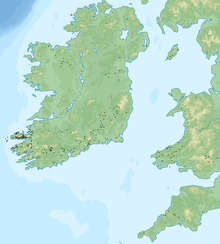This article should specify the language of its non-English content, using {{lang}}, {{transliteration}} for transliterated languages, and {{IPA}} for phonetic transcriptions, with an appropriate ISO 639 code. Wikipedia's multilingual support templates may also be used. (June 2021) |


Roughly 400 inscriptions in the ogham alphabet are known from stone monuments scattered around the Irish Sea, the bulk of them dating to the fifth and sixth centuries. The language of these inscriptions is predominantly Primitive Irish, but a few examples are fragments of the Pictish language. Ogham itself is an Early Medieval form of alphabet or cipher, sometimes also known as the "Celtic Tree Alphabet".
A number of different numbering schemes are used. The most common is after R. A. S. Macalister's Corpus Inscriptionum Insularum Celticarum (CIIC). This covers the inscriptions which were known by the 1940s. Another numbering scheme is given by the Celtic Inscribed Stones Project (CISP) and is based on the location of the stones; for example CIIC 1 = CISP INCHA/1. Macalister's (1945) numbers run from 1 to 507, including also Latin and Runic inscriptions, with three additional added in 1949. Sabine Ziegler (1994) lists 344 Gaelic ogham inscriptions known to Macalister (Ireland and Isle of Man), and seven additional inscriptions discovered later.
The inscriptions may be divided into "orthodox" and "scholastic" specimens. "Orthodox" inscriptions date to the Primitive Irish period, and record a name of an individual, either as a cenotaph or tombstone, or documenting land ownership. "Scholastic" inscriptions date from the medieval Old Irish period up to modern times.
The bulk of the surviving ogham inscriptions stretch in an arc from County Kerry (especially Corcu Duibne) in the south of Ireland across to Dyfed in south Wales. The remainder are, for the most part, found in south-eastern Ireland, eastern and northern Scotland, the Isle of Man, and England around the Devon/Cornwall border. The vast majority of the inscriptions consist of personal names, probably of the person commemorated by the monument.
